check engine light Peugeot Boxer 2016 Owner's Manual
[x] Cancel search | Manufacturer: PEUGEOT, Model Year: 2016, Model line: Boxer, Model: Peugeot Boxer 2016Pages: 292, PDF Size: 10.07 MB
Page 45 of 292
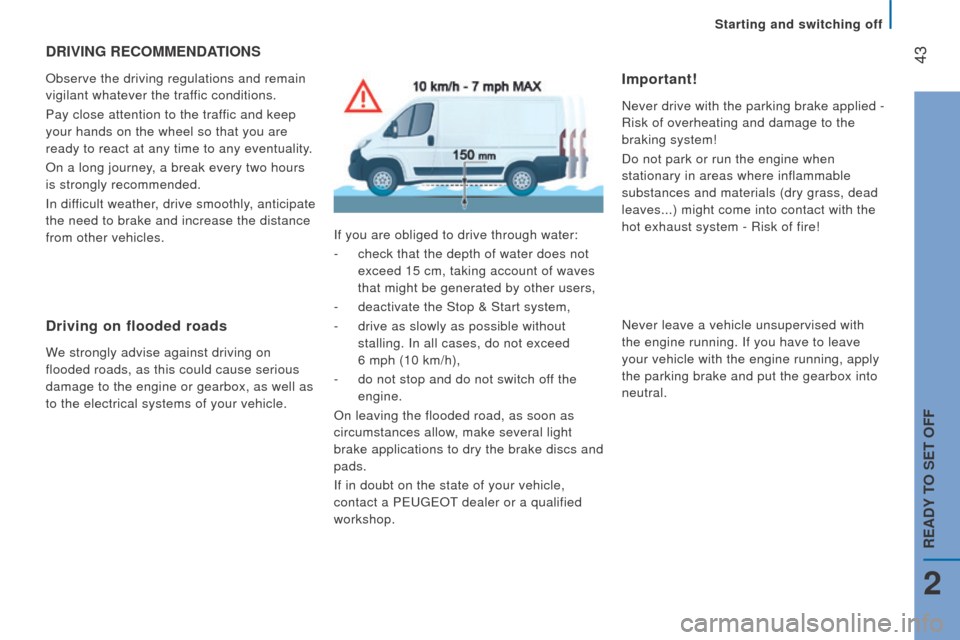
43
boxer_en_Chap02_Pret-a-Partir_ed01-2015
drIVInG rEcoMMEndAtI on S
Observe the driving regulations and remain
vigilant whatever the traffic conditions.
Pay close attention to the traffic and keep
your hands on the wheel so that you are
ready to react at any time to any eventuality.
On a long journey, a break every two hours
is strongly recommended.
In difficult weather, drive smoothly, anticipate
the need to brake and increase the distance
from other vehicles.
driving on flooded roads
We strongly advise against driving on
flooded roads, as this could cause serious
damage to the engine or gearbox, as well as
to the electrical systems of your vehicle. If you are obliged to drive through water:
-
check that the depth of water does not
exceed 15 cm, taking account of waves
that might be generated by other users,
-
deactivate the Stop & Start system,
-
drive as slowly as possible without
stalling. In all cases, do not exceed
6 mph (10 km/h),
-
do not stop and do not switch of
f the
engine.
On leaving the flooded road, as soon as
circumstances allow, make several light
brake applications to dry the brake discs and
pads.
If in doubt on the state of your vehicle,
contact a P
euge O t
dealer or a qualified
workshop.
Important!
Never drive with the parking brake applied -
Risk of overheating and damage to the
braking system!
Do not park or run the engine when
stationary in areas where inflammable
substances and materials (dry grass, dead
leaves...) might come into contact with the
hot exhaust system - Risk of fire!
Never leave a vehicle unsupervised with
the engine running. If you have to leave
your vehicle with the engine running, apply
the parking brake and put the gearbox into
neutral.
Starting and switching off
2
rEAdY to SEt oFF
Page 134 of 292
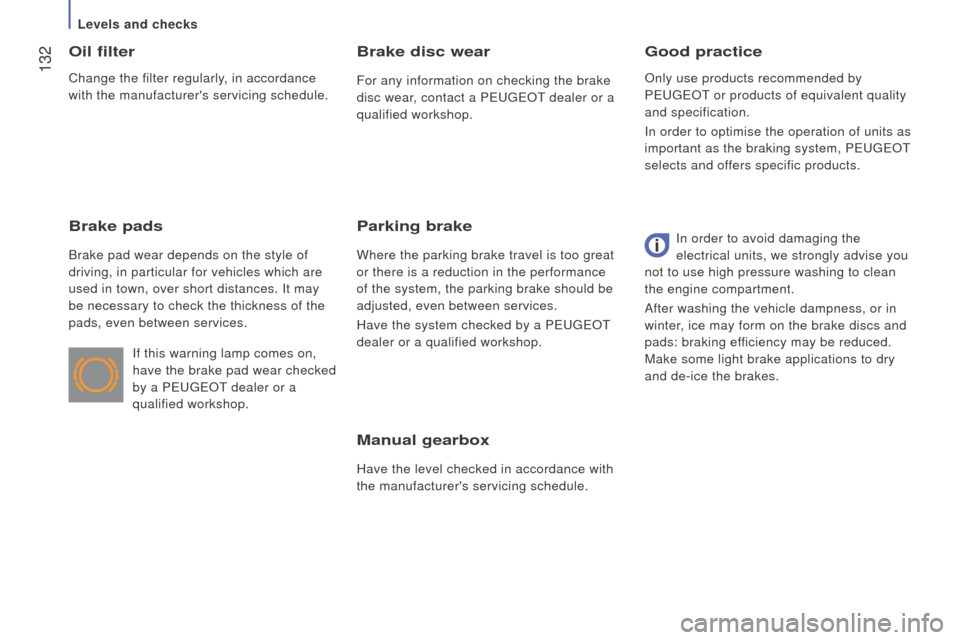
132
boxer_en_Chap07_Verifications_ed01-2015
Manual gearbox
Have the level checked in accordance with
the manufacturer's servicing schedule.
Good practiceo
il filter
Brake pads
Brake pad wear depends on the style of
driving, in particular for vehicles which are
used in town, over short distances. It may
be necessary to check the thickness of the
pads, even between services.
Brake disc wear
For any information on checking the brake
disc wear, contact a P euge O t
dealer or a
qualified workshop.
Parking brake
Where the parking brake travel is too great
or there is a reduction in the performance
of the system, the parking brake should be
adjusted, even between services.
Have the system checked by a P
euge O t
dealer or a qualified workshop.
If this warning lamp comes on,
have the brake pad wear checked
by a P
euge
O
t
dealer or a
qualified workshop. In order to avoid damaging the
electrical units, we strongly advise you
not to use high pressure washing to clean
the engine compartment.
After washing the vehicle dampness, or in
winter, ice may form on the brake discs and
pads: braking efficiency may be reduced.
Make some light brake applications to dry
and de-ice the brakes. Only use products recommended by
P euge O t
or products of equivalent quality
and specification.
In order to optimise the operation of units as
important as the braking system, P euge O t
selects and of
fers specific products.
Change the filter regularly, in accordance
with the manufacturer's servicing schedule.
Levels and checks
Page 145 of 292
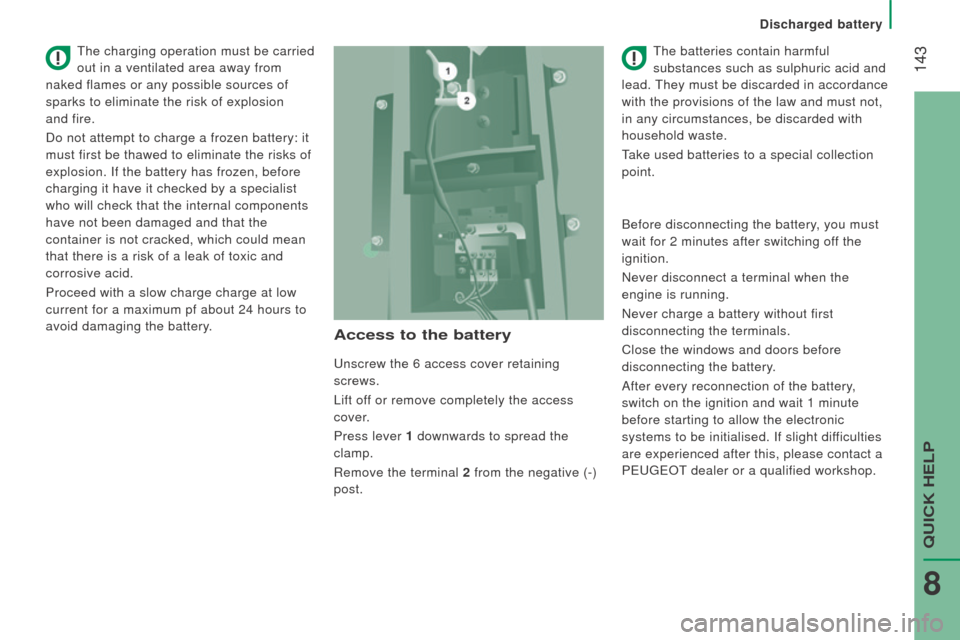
143
boxer_en_Chap08_Aide-Rapide_ed01-2015
Access to the battery
unscrew the 6 access cover retaining
screws.
Lift of
f or remove completely the access
cover.
Press lever 1 downwards to spread the
clamp.
Remove the terminal 2 from the negative (-)
post.
t
he batteries contain harmful
substances such as sulphuric acid and
lead.
t
hey must be discarded in accordance
with the provisions of the law and must not,
in any circumstances, be discarded with
household waste.
take used batteries to a special collection
point.
t
he charging operation must be carried
out in a ventilated area away from
naked flames or any possible sources of
sparks to eliminate the risk of explosion
and fire.
Do not attempt to charge a frozen battery: it
must first be thawed to eliminate the risks of
explosion. If the battery has frozen, before
charging it have it checked by a specialist
who will check that the internal components
have not been damaged and that the
container is not cracked, which could mean
that there is a risk of a leak of toxic and
corrosive acid.
Proceed with a slow charge charge at low
current for a maximum pf about 24 hours to
avoid damaging the battery. Before disconnecting the battery, you must
wait for 2 minutes after switching off the
ignition.
Never disconnect a terminal when the
engine is running.
Never charge a battery without first
disconnecting the terminals.
Close the windows and doors before
disconnecting the battery.
After every reconnection of the battery,
switch on the ignition and wait 1 minute
before starting to allow the electronic
systems to be initialised. If slight difficulties
are experienced after this, please contact a
P
euge O t
dealer or a qualified workshop.
Discharged battery
QuICK HeLP
8
Page 150 of 292
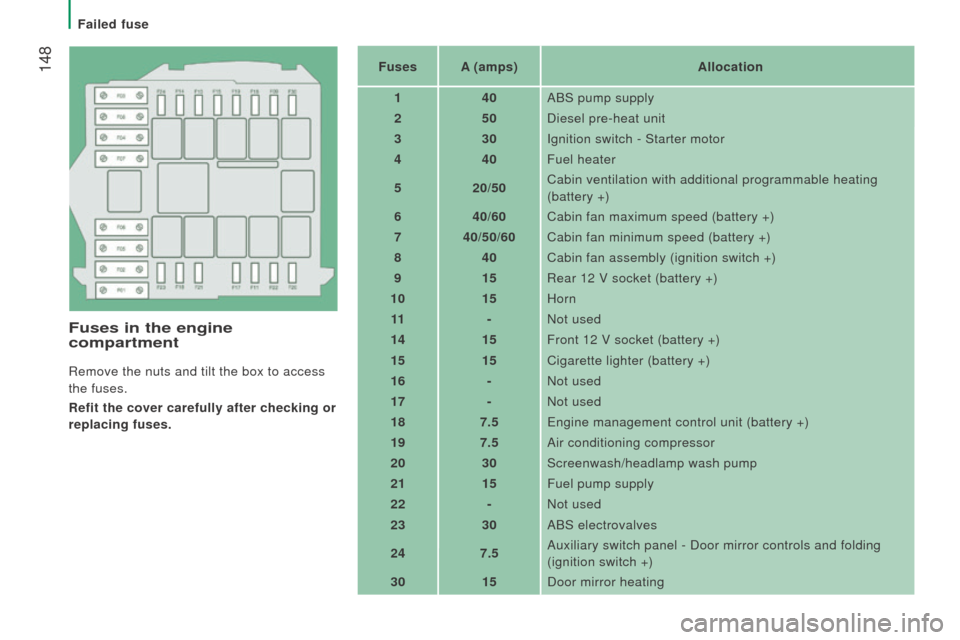
148
boxer_en_Chap08_Aide-Rapide_ed01-2015
Fuses in the engine
compartment
Remove the nuts and tilt the box to access
the fuses.
r
efit the cover carefully after checking or
replacing fuses. Fuses
A (amps) Allocation
1 40ABS pump supply
2 50Diesel pre-heat unit
3 30Ignition switch - Starter motor
4 40Fuel heater
5 20/50Cabin ventilation with additional programmable heating
(battery +)
6 40/60Cabin fan maximum speed (battery +)
7 40/50/60 Cabin fan minimum speed (battery +)
8 40Cabin fan assembly (ignition switch +)
9 15Rear 12 V socket (battery +)
10 15Horn
11 -Not used
14 15Front 12 V socket (battery +)
15 15Cigarette lighter (battery +)
16 -Not used
17 -Not used
18 7.5
e
ngine management control unit (battery +)
19 7.5Air conditioning compressor
20 30Screenwash/headlamp wash pump
21 15Fuel pump supply
22 -Not used
23 30ABS electrovalves
24 7.5Auxiliary switch panel - Door mirror controls and folding
(ignition switch +)
30 15Door mirror heating
Failed fuse
Page 264 of 292
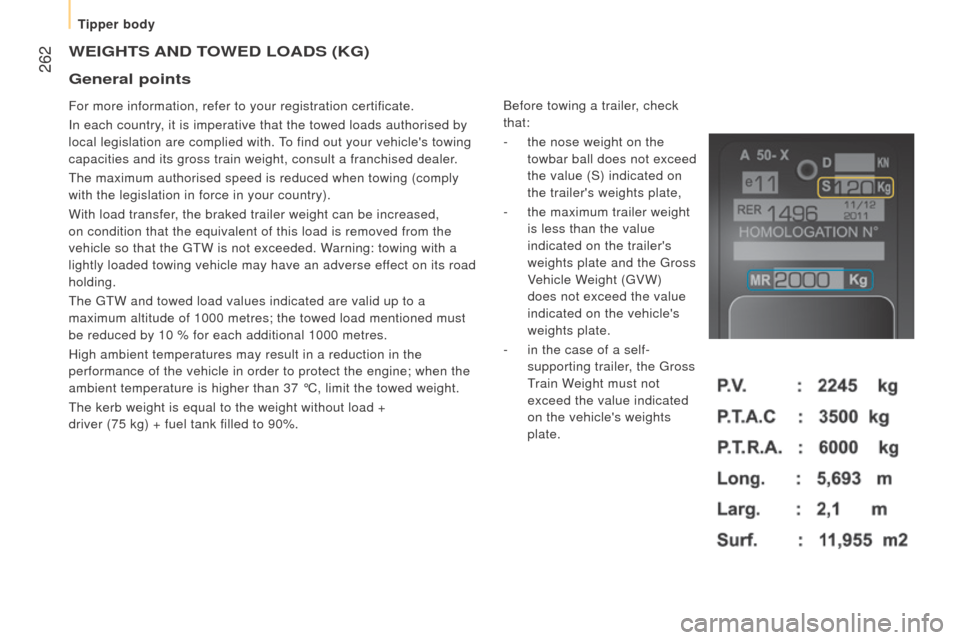
262
boxer_en_Chap11_Particularites_ed01-2015
WEIGHtS And to WE d L o A d S ( KG )
For more information, refer to your registration certificate.
In each country, it is imperative that the towed loads authorised by
local legislation are complied with.
to find out your vehicle's towing
capacities and its gross train weight, consult a franchised dealer.
t
he maximum authorised speed is reduced when towing (comply
with the legislation in force in your country).
With load transfer, the braked trailer weight can be increased,
on condition that the equivalent of this load is removed from the
vehicle so that the
gt W is not exceeded. Warning: towing with a
lightly loaded towing vehicle may have an adverse effect on its road
holding.
t
he gt W and towed load values indicated are valid up to a
maximum altitude of 1000 metres; the towed load mentioned must
be reduced by 10 % for each additional 1000 metres.
High ambient temperatures may result in a reduction in the
performance of the vehicle in order to protect the engine; when the
ambient temperature is higher than 37 °C, limit the towed weight.
t
he kerb weight is equal to the weight without load +
driver
(75 kg) + fuel tank filled to 90%. Before towing a trailer, check
that:
-
the nose weight on the
towbar ball does not exceed
the value (S) indicated on
the trailer's weights plate,
-
the maximum trailer weight
is less than the value
indicated on the trailer's
weights plate and the
g ross
Vehicle Weight (
g VW)
does not exceed the value
indicated on the vehicle's
weights plate.
-
in the case of a self-
supporting trailer
, the g ross
train W
eight must not
exceed the value indicated
on the vehicle's weights
plate.
General points
tipper body